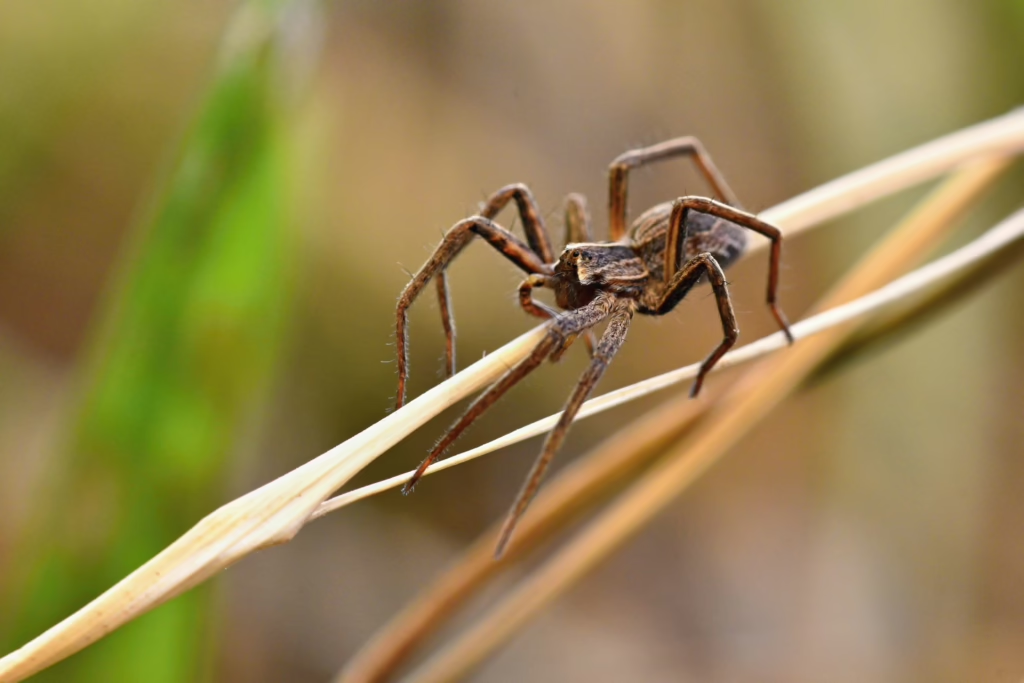Encountering spiders in your home or yard is a common experience. While many species are harmless, identifying them can help you understand their behavior and take appropriate preventative measures. This article will introduce you to common spider species you might encounter in the Southern Ontario region.
Common Spiders in Your Home and Yard
Wolf Spider
Wolf spiders are frequently found in the darker, damp areas of homes and are quite common in Southern Ontario. You can identify them by their varied coloration, often a mix of brown, orange, black, and grey. Their eye arrangement is distinct: four small eyes on the bottom row, two larger eyes in the middle, and a pair of medium-sized eyes on the back row that face outwards. These spiders are nocturnal hunters and prefer to live solitarily, meaning you typically won’t find a large infestation of them. They create nests in leaf litter, grassy areas, and small tunnels.
Wolf spiders can actually be beneficial, as they help control populations of other, more harmful pests. To prevent them from entering your home, ensure your yard is clear of debris, trash bins are sealed, and any moisture buildup is addressed. While generally not aggressive, wolf spiders will bite if they feel trapped or are handled. Fortunately, their bites are not venomous and are usually described as a pinch or sting, not a serious threat. Unlike many other spiders, wolf spiders do not build webs to catch prey. They are most likely to seek warmth indoors during the fall as temperatures drop. However, they can sometimes be mistaken for the highly venomous brown recluse spider due to similar appearances. If you are unsure about a spider’s identity, it’s best to consult with a pest control expert.
Cellar Spiders
Often referred to as “daddy longlegs” due to their extremely long, thin legs, cellar spiders are a very common sight in homes throughout Southern Ontario. Unlike harvestmen, which are not true spiders, cellar spiders are legitimate arachnids that build intricate, albeit messy, webs in dark, damp, and undisturbed areas like basements, crawl spaces, and corners of garages. Their bodies are small and compact, and they can often be seen hanging upside down in their webs. While their appearance can be startling, cellar spiders are completely harmless to humans and are non-aggressive. In fact, they are beneficial house guests as they prey on other insects and even other spiders.
To prevent them from taking up residence, focus on reducing humidity in your basement with a dehumidifier and sealing any cracks in your foundation that could serve as entry points. Like other spiders, they are drawn to areas with an abundant food source, so maintaining a tidy home and controlling other pests will naturally make your space less attractive to them.
Jumping Spider
Jumping spiders are another common species in Southern Ontario, particularly in areas like Windsor-Essex County. These spiders build a loose, less intricate web structure called a “retreat,” which they use for shelter and protection rather than for hunting. You are more likely to spot jumping spiders during the day, as this is when they actively hunt.
They often nest around well-lit areas such as windows and doors. You can identify jumping spiders by their fast reactions, high jumps, and quick crawling movements. They have a compact body shape and four large eyes that face outwards. Their coloration typically ranges from black, brown, or tan, though some species boast more vibrant markings like green or blue. Their size can vary from 4 to 20 millimeters. Jumping spiders can easily enter your home through small openings, including tiny gaps, holes, or noticeable cracks in the foundation. Regular home maintenance, such as sealing cracks, is the best way to keep them out. Similar to wolf spiders, jumping spiders can be helpful in controlling other insects in your home. They tend to flee when threatened rather than attack, though their rapid movements can sometimes be startling.
House Spider
House spiders, while generally similar in behavior, exhibit a wide range of appearances. Their color can vary from white to black, and their size can range from very tiny to quite long, with an average measurement of about 6 to 8 millimeters in length and roughly 3 millimeters in width. Other identifying features include a brownish-yellow hue on the spider’s abdomen or comb-like hairs on their legs. The most common sign of a house spider infestation is the presence of cobwebs in areas like windows, ceiling corners, or between household fixtures. An unusually high number of spider corpses can also indicate a possible infestation.
To deter house spiders, regularly clean indoor areas where they might build nests, paying close attention to basements and crawl spaces, as these are preferred nesting sites. Additionally, keep an eye on woodpiles or compost piles located close to your home, as house spiders are attracted to these outdoor areas for nesting. The average female American house spider can produce light-brown egg sacs, each containing approximately 150 to 400 eggs, which typically hatch in about a month. House spiders can live for about a year and are capable of producing thousands of offspring during their lifespan.
Spider Prevention: A Proactive Approach
Preventing spiders from entering your home is an essential part of effective pest management. By understanding what attracts spiders—including other pests, dark spaces, and moisture—you can take proactive steps to make your home a less welcoming environment. Simple measures like sealing cracks and crevices, decluttering basements and attics, and regularly cleaning can make a significant difference. For a comprehensive guide on how to keep spiders out of your home, including detailed tips on sealing entry points and eliminating food sources, we invite you to read our full article on spider prevention. Taking these steps not only deters spiders but also helps manage a variety of other household pests.
Taking proactive steps to remove these spiders as soon as you notice an infestation can significantly help manage their populations in your home. If you suspect a significant infestation, contacting The Spider Guys can provide the necessary expertise.

